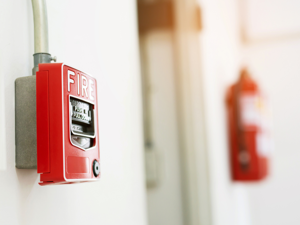Fire doors are a critical component of fire safety in commercial and residential buildings in the UK. But not all fire doors are the same. Depending on the application and fire rating required, different types of fire doors are used.
In the UK, fire door ratings are most commonly classified using the FD30 and FD60 systems. FD30 doors are tested to resist fire for 30 minutes, while FD60 doors can withstand fire for 60 minutes. There is also an FD120 standard.
Doors are also required to adhere to certain British Standards including:
- BS 476 - Specifies fire testing methods.
- BS EN 1634 - Fire resistance testing standards.
- BS 8214 - Standards for installed fire door sets.
There are further detailed British Standard Institute requirements which relate to each type of fire door and their components which may apply depending on your circumstances; more information can be found on their website.
Timber Fire Doors
The most common type of fire door in the UK is made from timber. Timber fire doors have a solid hardwood or softwood timber core enclosed in panels of fire-resistant hardwood; there are also options with a composite or engineered core. Intumescent strips around the edges expand when exposed to heat, sealing any gaps. Timber fire doors provide a cost-effective FD30 (30-minute) fire resistance rating.
Steel Fire Doors
Steel fire doors are a popular choice for situations requiring greater fire resistance of FD60 (60 minutes) or longer. They are constructed with steel skins enclosing a core of fire-resistant insulation. The thermal expansion properties of steel provide excellent sealing when exposed to heat. Steel doors are highly durable but heavier than timber.
Glass Fire Doors
Glass fire doors feature large vision panels made from fire-resistant glazing complying with BS EN 14449 standards. This allows visibility through the door while maintaining fire rating integrity up to FD30.
Sliding Fire Doors
Sliding fire doors are designed for applications where a conventional hinged door is impractical. They slide horizontally into the wall cavity and are self-closing in the event of a fire. These doors also incorporate fire-rated glazing for visibility.
Automatic Fire Doors
Automatic fire doors feature self-closing mechanisms that engage when a fire is detected or an alarm sounds. These doors typically use sensors, such as heat or smoke detectors, to trigger the self-closing mechanism. When a fire is detected, the sensors send a signal to the door's mechanism, causing it to close automatically.
This technology is a crucial safety feature, as it ensures that fire doors close promptly in the event of a fire, helping to contain the fire and protect building occupants. This reduces the need for human intervention to close doors in an emergency. These doors can come in hinged or sliding configurations and are available with various fire resistance ratings
No matter what type of application, there is a fire door solution to meet UK fire safety standards.
When installed and maintained correctly, fire doors will serve as a key safeguard to contain fires and protect building occupants.








